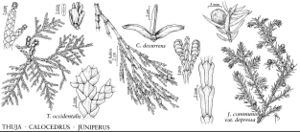Thuja occidentalis
Sp. Pl. 2: 1002. 1753.
Trees to 15 (–38) m, stunted or prostrate in harsh environments; trunk to 0.9 (–1.8) m diam., sometimes divided into 2–3 secondary stems, often reproducing by layering or forming erect, rooted branches from fallen trunks; crown conical. Bark reddish-brown or grayish brown, 6–9 mm thick, fibrous, fissured. Leaves of branchlets (1.5–) 3–5 mm, acute, dull yellowish green on both surfaces of branchlets. Pollen cones 1–2 mm, reddish. Seed-cones ellipsoid, (6–) 9–14 mm, brown; fertile scales usually 2 pairs, each minutely mucronate. Seeds ca. 8 per cone, 4–7 mm (including wings), reddish-brown. 2n = 22.
Habitat: On mostly calcareous substrates, neutral to basic swamps, shores of lakes and rivers, uplands, cliffs, and talus
Elevation: 0–900 m
Distribution

Man., N.B., N.S., Ont., P.E.I., Que., Conn., Ill., Ind., Ky., Maine, Md., Mass., Mich., Minn., N.H., N.Y., N.C., Ohio, Pa., Tenn., Vt., Va., W.Va., Wis.
Discussion
Isolated stands of Thuja occidentalis occur north and east of its general range in Canada (to 51° 31' N latitude in Ontario, 50° N in Quebec). In the United States south of the Great Lakes and in southern New England, it occurs locally in scattered stands and is rare or extirpated at numerous former sites. In some areas, heavy winter browsing by deer greatly reduces reproductive success through elimination of seedlings or saplings.
Thuja occidentalis is widely utilized in ornamental silviculture and has more than 120 named cultivars. It was probably the first North American tree introduced into Europe (ca. 1566). It is an important timber tree; the wood is used for applications requiring decay resistance.
Selected References
None.
Lower Taxa
"with slightly enlarged apex" is not a number. "thin" is not a number. "thin" is not a number.
